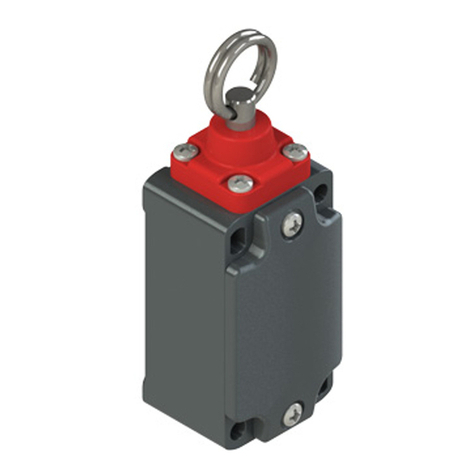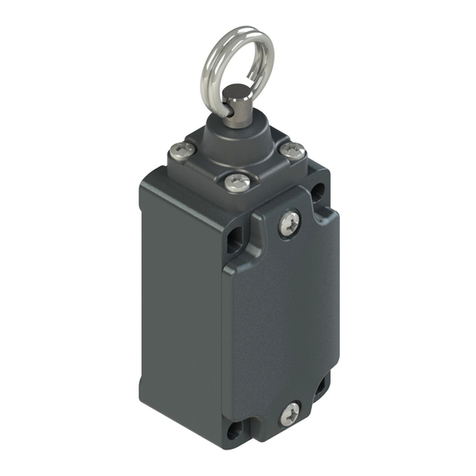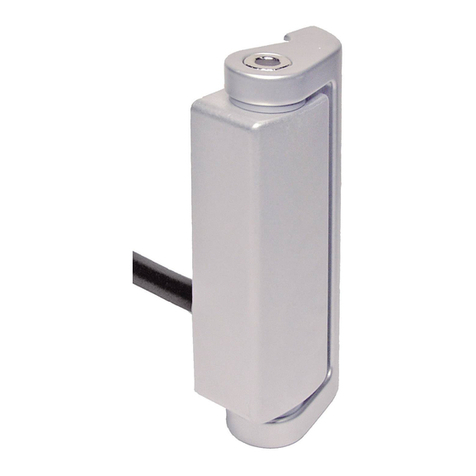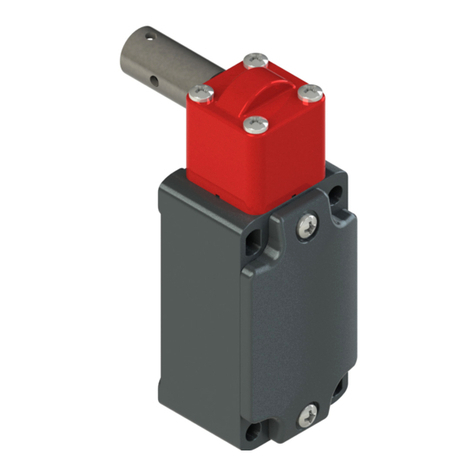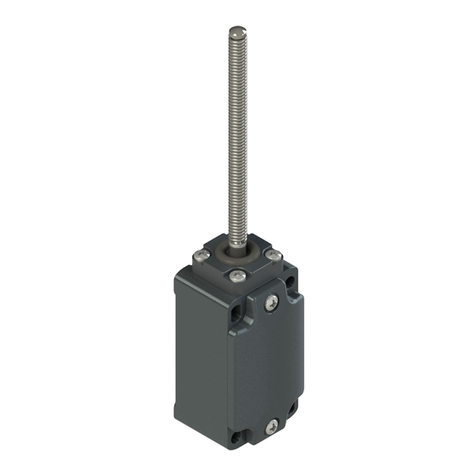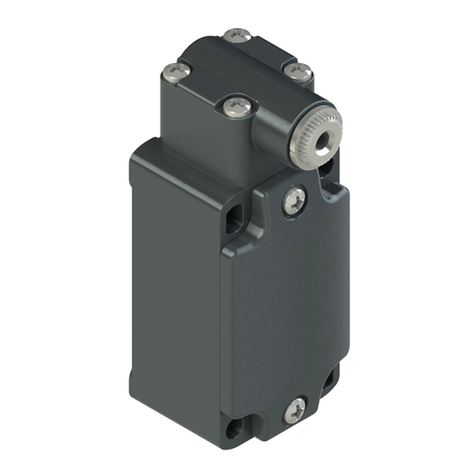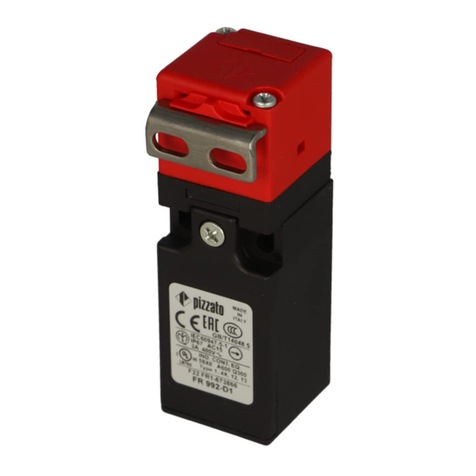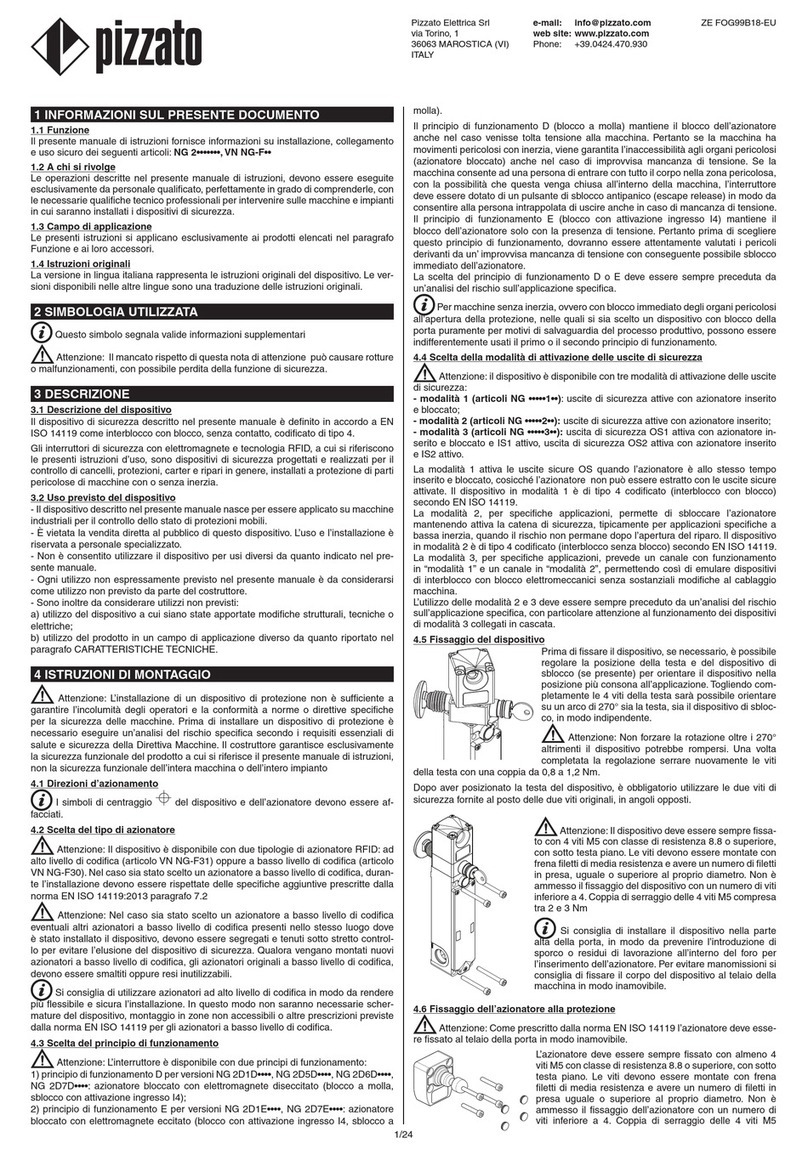
8/12
5.1Contrôleaccès
Cet interrupteur seul n'est pas en mesure de protéger les opérateurs ou les
personnes chargées de l’entretien au cas où ces derniers entreraient complètement
dans la zone de danger, car une fermeture involontaire de la protection derrière eux
permettrait la remise en marche de la machine. Si l'autorisation de redémarrage
de la machine dépend entièrement de ce dispositif, il faut prévoir des systèmes de
protection supplémentaires (Lock out/Tag out - Consignation) pour éviter ce risque ; il
est possible par exemple d'utiliser le dispositif verrouillable servant à bloquer l'entrée
de l'actionneur (article VF KB1), spécialement conçu pour empêcher tout démarrage
imprévu de la machine lorsque l'opérateur est encore à l'intérieur.
Pour plus d'informations, contacter l'assistance technique (voir le paragraphe
SUPPORT).
5.2Utilisationdudéverrouillageavecserrure
Les articles FD ••99, FP ••99 sont équipés d'un déverrouillage à serrure pour
permettre l'ouverture du protecteur uniquement au personnel autorisé, muni de la clé
spéciale fournie. Ce dispositif mécanique agit directement sur le méca-
nisme de verrouillage, relâchant immédiatement l'action-
neur, indépendamment des conditions dans lesquelles
se trouve le dispositif.
Seul un technicien d'entretien de la machine, correcte-
ment instruit sur les dangers dérivant de l'utilisation de
ce dispositif de déverrouillage, est autorisé à l'actionner.
Procédure d'utilisation du déverrouillage auxiliaire à
serrure :
1) Ouvrir le capuchon de protection.
2) Introduire la clé fournie avec l'interrupteur et tourner de
180° dans le sens horaire.
3) Ne pas forcer la clé au-delà de 180°.
4) Extraire l’actionneur du dispositif.
5) Ne pas tourner la clé une fois l'actionneur extrait.
6) Chaque fois que la clé est retirée, fermer le capuchon en caoutchouc.
Attention :
- La clé de déverrouillage doit être uniquement à la disposition du technicien d'entre-
tien de la machine et doit être conservée dans un endroit retiré.
- La clé de déverrouillage ne doit pas être mise à disposition de l'opérateur de la
machine.
- La clé de déverrouillage ne doit pas être laissée dans le dispositif pendant l'utilisation
normale de la machine.
5.3Utilisationdudéverrouillageàretardmécaniquemanuel
Les articles FD ••R2, FP ••R2 sont équipés d'un déverrouillage à retard mécanique
manuel pour les cas où la condition de danger se prolonge un certain temps, même
après avoir actionné la commande d'arrêt de la machine.
Ce dispositif mécanique agit directement sur le méca-
nisme de verrouillage, relâchant l'actionneur, indépen-
damment des conditions dans lesquelles se trouve le
dispositif.
Procédure d'utilisation du déverrouillage auxiliaire à re-
tard mécanique manuel :
1) Pour déverrouiller l'actionneur, tourner le bouton dans
le sens horaire jusqu'à son arrêt en fin de course, seule-
ment alors extraire l'actionneur.
2) Pour verrouiller l'actionneur, insérer celui-ci dans le dis-
positif, seulement alors tourner le bouton dans le sens
antihoraire jusqu'à son arrêt en fin de course.
3) Ne pas forcer le bouton en le tournant dans le sens
antihoraire après extraction de l'actionneur.
6MISESENGARDEPOURUNEUTILISATIONCORRECTE
6.1 Installation
- Serrer les vis de fixation des conducteurs électriques avec un couple compris entre
0,6 et 0,8 Nm.
- Ne pas soumettre le dispositif à des contraintes de flexion ou de torsion.
- Ne pas modifier en aucun cas le dispositif.
- Ne pas dépasser les couples de serrage indiqués dans le présent manuel.
- Le dispositif sert à protéger les opérateurs. Une mauvaise installation ou une mani-
pulation intempestive peuvent causer de graves blessures, voire la mort, des dom-
mages matériels et des pertes économiques.
- Ces dispositifs ne doivent pas être contournés, enlevés, tournés ni désactivés par
d'autres moyens.
- Si la machine, munie de ce dispositif, est utilisée à des fins autres que celles qui
sont spécifiées, le dispositif pourrait ne pas protéger l'opérateur de manière efficace.
- La catégorie de sécurité du système (selon EN ISO 13849-1) comprenant le dis-
positif de sécurité dépend aussi des composants extérieurs qui y sont reliés et de
leur typologie.
- Avant l'installation, s'assurer que le dispositif est totalement intact.
- S'abstenir de plier les câbles de connexion de manière excessive afin d'éviter les
courts-circuits et les coupures.
- Ne pas vernir ni peindre le dispositif.
- Ne pas percer le dispositif.
- Ne pas utiliser le dispositif comme support ou appui pour d'autres structures (che-
mins, guides de glissement ou autres).
- Avant la mise en service, veiller à ce que l'ensemble de la machine, ou le système,
soient bien conformes aux normes applicables et aux exigences de la directive sur
la compatibilité électromagnétique.
- La surface de montage du dispositif doit toujours être propre et plane.
- La documentation requise pour une installation et un entretien corrects est toujours
disponible dans les langues suivantes : anglais, français, allemand, italien.
- Si l'installateur n'est pas en mesure de comprendre pleinement la documentation,
il ne doit pas procéder à l'installation du produit et peut demander de l'aide (voir
paragraphe SUPPORT).
- Quand le dispositif est installé sur un châssis mobile et que l'actionneur est installé
sur une porte également mobile, veiller à ce que le dispositif ne soit pas endom-
magé par l'ouverture simultanée du châssis et de la porte.
- Toujours joindre les présentes prescriptions d’utilisation au manuel de la machine
sur laquelle le dispositif est installé.
- La conservation des présentes prescriptions d’utilisation doit permettre de les
consulter sur toute la durée d'utilisation du dispositif.
6.2Nepasutiliserdanslesenvironnementssuivants
Attention : Ne pas utiliser dans les environnements où poussières et saleté
peuvent pénétrer dans la tête et sédimenter. Ne pas utiliser notamment dans les
environnements où de la poussière métallique, du ciment ou des produits chimiques
sont pulvérisés.
- Environnement dans lequel des variations permanentes de la température en-
traînent l'apparition de condensation à l'intérieur du dispositif.
- Environnement dans lequel l'application comporte des vibrations et des chocs im-
portants pour le dispositif.
- Dans les environnements où des poussières ou gaz explosifs ou inflammables sont
présents. Cette limitation ne s’applique pas aux appareils déclarés conformes à la
directive ATEX 2014/34/EU.
- Dans des espaces où des manchons de glace peuvent se former sur le dispositif.
- Environnement contenant des substances chimiques fortement agressives et dans
lequel les produits entrant en contact avec le dispositif risquent de compromettre
son intégrité physique et fonctionnelle.
6.3Arrêtmécanique
Attention : La porte doit toujours être équipée d'un arrêt mécanique indépendant,
au bout de sa course de fermeture.
Ne pas utiliser le dispositif comme arrêt mécanique de la porte.
6.4Entretienetessaisfonctionnels
Attention : Ne pas démonter ni tenter de réparer le dispositif. En cas de
défaillance ou de panne, remplacer le dispositif tout entier.
Attention : En cas d’endommagement ou d’usure, il faut remplacer tout le
dispositif, compris l’actionneur. Le fonctionnement n'est pas garanti en cas de
dispositif déformé ou endommagé.
- L'installateur est tenu de déterminer une séquence de tests fonctionnels à laquelle
soumettre le dispositif, avant la mise en service de la machine et pendant les inter-
valles d'entretien.
- La séquence des tests fonctionnels peut varier en fonction de la complexité de la
machine et de son schéma de circuit ; la séquence de tests fonctionnels indiquée
ci-après doit donc être considérée comme étant minimum et non exhaustive.
- Avant de mettre la machine en service et au moins une fois par an (ou après un arrêt
prolongé), effectuer la séquence de tests suivante :
1) Pour les articles FD ••93, FP ••93, FL ••93, FC ••93 :
- Ouvrir la protection avec la machine en mouvement. La machine doit s'arrêter
immédiatement. Le temps d'arrêt de la machine doit toujours être inférieur au temps
que l'opérateur met à ouvrir la protection et à atteindre les éléments dangereux.
Pour les articles FD ••99, FP ••99 :
- Verrouiller la protection et mettre la machine en marche. Il doit être impossible
d'ouvrir la protection.
- Déverrouiller la protection avec la clé prévue à cet effet. La machine doit s'arrêter
immédiatement. Le temps d'arrêt de la machine doit toujours être inférieur au temps
que l'opérateur met à ouvrir la protection et à atteindre les éléments dangereux.
Pour les articles FD ••R2, FP ••R2 :
- Verrouiller la protection et mettre la machine en marche. Il doit être impossible
d'ouvrir la protection.
- Commencer à tourner le bouton de déverrouillage dans le sens horaire. La ma-
chine doit entamer son arrêt dès les premiers tours. La machine doit s'arrêter com-
plètement avant que la porte ne soit déverrouillée par la rotation du bouton dans le
sens horaire. Le temps d'arrêt de la machine doit toujours être inférieur au temps
que l'opérateur met à ouvrir la protection et à atteindre les éléments dangereux.
2) Avec la protection ouverte, essayer de mettre la machine en marche. La machine
ne doit pas démarrer.
3) Vérifier l'alignement correct entre l'actionneur et le dispositif. Si le point d'insertion
de l'actionneur est usé, remplacer tout le dispositif et son actionneur.
4) Toutes les parties extérieures doivent être en bon état.
5) Si le dispositif est endommagé, le remplacer complètement.
6) L'actionneur doit être solidement fixé à la porte ; s'assurer qu'aucun des outils
utilisés par l'opérateur de la machine n'est en mesure de détacher l'actionneur de
la porte.
7) En cas de difficulté d'insertion de l'actionneur dans l'interrupteur, ne pas intro-
duire d'huile ou de graisse dans la tête de l'interrupteur, mais vérifier l'alignement
de l'actionneur comme décrit au paragraphe INSTRUCTIONS DE MONTAGE. Si
l'insertion de l'actionneur continue d'être difficile, remplacer l'ensemble du dispositif.
8) Le dispositif a été conçu pour des applications dans des environnements dange-
reux, son utilisation est donc limitée dans le temps. 20 ans après la date de fabrica-
tion, il faut entièrement remplacer le dispositif, même s'il marche encore. La date de
fabrication est indiquée à côté du code du produit (voir paragraphe MARQUAGES).
6.5Câblage
Attention : Vérifier que la tension d'alimentation est correcte avant de brancher
le dispositif.
- Maintenir la charge dans les plages de valeurs électriques indiquées dans les
catégories d'emploi.
- Brancher et débrancher le dispositif uniquement lorsqu'il est hors tension.
- Durant et après l'installation, ne pas tirer sur les câbles électriques qui sont reliés
au dispositif.
- Toujours brancher le fusible de protection (ou tout dispositif équivalent) en série sur
les contacts électriques de sécurité.
- En fin de câblage, vérifier qu'aucun élément contaminant n'a été introduit à l'intérieur
du dispositif.
- Avant de fermer le couvercle du dispositif, vérifier que les joints de fixation sont bien
positionnés.
